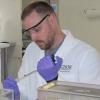@All:
I recently underwent a voluntary, not clinically indicated bone marrow aspiration to long term store my own adult stem cells with a cord blood/stem cell bank for future use. I should add that I am relatively young and want to have young autologous stem cells available in case future therapies arrive. As in searching for a company that offers those kind of service I encountered some fraudulent services, therefore I will add a word or two for those of you who might consider doing something similar. If you need a read up about stem cells http://stemcells.nih.gov/ as always is one of the best general science sites available.
Disclaimer: I have no commercial interest of any kind in giving the following statements and no company names will be given.
Various stem cell banks offer the storage of one’s own adult stem cells. However, not every service is equal, as not every kind of service gets the same cell count or types of stem cells. In the end it boils down to the source they are taking advantage of to extract the cells. In general 5 types of sources are employed:
- cord blood and cord blood tissue, dental pulp of deciduous teeth/molars (summarised as “you are too old (YATO)” sources)
- bone marrow
- mobilised peripheral bloodstem-cells (PBSC)
- adipose tissue
- normal blood samples
The kinds of adults stem cells under consideration with those sources are especially:
- mesenchymal stem cells (MSC)
- hematopoietic stem cells (HSC)
- endothelial stem cells (ESC)
HSC are a class of blood forming cells from which every type of blood cell is derived from. They are key in treating leukaemia and other diseases of the blood/immune system.
MSC are special kind of cells. Various types of tissue derive from them: bone forming cells, cartilage cells, all kinds of connective tissue, fat cells, muscle cells (including heart cells) and they are suspected to form nerve cells and/or promote nerve regeneration if introduced into such tissue.
ESC form endothelial cells, which cover the inner lining of blood vessels and are especially relevant for the lung in this regard.
_____________________________________
At the moment only HSC are routinely used to cure conditions. However, MSC appear to have the most potential for possible future stem cell therapies. In the end though it might not matter:
- as soon as cells from young donors can be manipulated in a way that they form advanced, secure pluri- or even totipotent cells which (importantly!) are compatible and immunological accepted by an unrelated patient every kind of banking becomes unnecessary – but it’s a long shot
- as soon as advanced, secure pluri-/totipotent cells can be derived from any kind of differentiated cell or adult stem cell it does not matter which kind of cell is stored
- according to the state of cell expansion technologies the cell count could play a less important role (note though that *at the moment* external cell proliferation also in involves in vitro aging which might be hard to overcome at all)
So in line with your own judgement of those future conditions you can come to different conclusions about the banking options. For the following assessments I will assume the current state of the art and likely developments in the medium run, so the conditions above are not yet met.
_____________________________________
Ideally you would like to store all 3 types of cells with a large cell count, e.g. a below a certain cell count level cancer treatments are not possible with HSC. As already mentioned MSC are the most flexible ones and are able to form numerous relevant tissues. Therefore I will rank them as MSC > HSC > ESC and will neglect ESC in the further analysis, also as they do not play any major role in current stem cell research.
YATO cells:
In principle a rich source of young HSC and MSC, but unfortunately the average reader will not have the advantage of this option. If you consider storing the cord blood of your new born please note that it is a rich source of HSC, but not (!) MSC which normally can not be readily cultured from cord blood. The cord itself is a rich source of MSC if processed properly.
Bone marrow:
A rich source of both MSC and HSC. It is harvested with needle aspiration, which causes pain for some short moments if done under local anaesthesia. Usually an outpatient procedure with discharging a couple of hours afterwards, unless you are opting for general anaesthesia. If you need it the latter itself is the biggest health risk and cost factor involved in this option.
mobilised PBSC:
A rich source of HSC, but not MSC. For some days before the procedure you are injected growth factors (usually G-CSF) which enormously increase the release of HSC into the blood stream. Those are subsequently filtered out by letting your blood flow through a special kind dialysis machine, which takes a couple of hours. MSC, if present at all, have a very low cell count in the final sample. The growth factors cause some discomfort and are very expensive. Be sceptical if the service provider just takes one normal blood sample instead of filtering for the HSC, as this of course reduces the achievable amount of HSC considerably.
Adipose tissue:
A very rich source of MSC, but no HSC are present. The concentration of MSC is even higher than in bone marrow. Normally 100ml to 200ml of fat are harvested and processed to retrieve the MSC. Not a lot of research is done on clinical applications for MSC derived from fat, but the cells are in principle not less viable than those derived from marrow.
normal blood samples:
A poor source of both HSC and MSC. While in principle present, HSC have a low cell count in normal blood samples. If present at all, MSC have a very low cell count in the sample.
To summarize, bone marrow and adipose tissue are the only reasonable options if you intend to bank MSC. If you intend to bank HSC, mobilised PBSC and bone marrow are the way to go. YATO-cells are not an option and one might question whether normal blood samples qualify as adult stem cell banking. Most people would want to store adult stem cells collected from bone marrow or adipose tissue, as for various reasons MSC appear to be the most promising cells for stem cell therapies. This includes the kind of tissue they can form and the recent focus on MSC-derived iPS-cells.
Edited by TFC, 19 September 2011 - 03:06 PM.















































